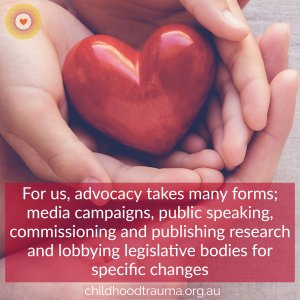
What is advocacy in child protection environments?
This blog entry was authored by Lauren Thomas, Program Manager,
Professional Community Engagement at the Australian Childhood Foundation
Recently, a member of the community wrote in asking about what the Australian Childhood Foundation does to advocate for children. They wanted to know what advocacy was, how the Foundation was involved in advocacy endeavours and how we felt the community could help.
My professional bio also lists me as ‘a passionate advocate for children’ – there a many of us now who are. But we may not fit the more traditional picture of advocates that can come to mind; that type of advocacy which is the role of a political lobbyist.
I confess that when I first read these questions, my mind immediately went to lobbyist types of advocacy. But there is much we do here at the Foundation, and possibly that you do as a member of a community, that is aimed at influencing decisions within political, economic, and social systems and institution, or perhaps just aimed at influencing thinking, debate and discussion in your social settings. [i]
 This kind of work is important to the Foundation for many reasons, particularly where it pertains to the needs of children. Children are made vulnerable in societies where they are not listened to, and where they do not have a strong or prioritised voice (for more on this topic click here). And, as a child-centred workplace, we too often see how this manifests for children who have experienced abuse; their stories are not believed, and their help-seeking behaviours are not understood.
This kind of work is important to the Foundation for many reasons, particularly where it pertains to the needs of children. Children are made vulnerable in societies where they are not listened to, and where they do not have a strong or prioritised voice (for more on this topic click here). And, as a child-centred workplace, we too often see how this manifests for children who have experienced abuse; their stories are not believed, and their help-seeking behaviours are not understood.
For us, advocacy takes many forms; media campaigns, public speaking, commissioning and publishing research and lobbying legislative bodies for specific changes. We do join in lobbying Government and peak bodies around the importance of child-inclusive practice and models of intervention which understand the impact of trauma on the neurobiology and physiology of children. We believe that where systems are informed by this knowledge, they are less likely to offer interventions that are behaviourist and simplistic, and more likely to be tolerant of the complexities present in these children’s stories and cases.
Our current community campaign “Defend Childhood” was launched on the same day as our new logo, with the goal to empower all of us to take the lead in resourcing and celebrating relationships in which children are loved, cared for and protected.
We also advocate for community awareness around the issue, size, complexity and research about child abuse and trauma. These endeavours include increasing public awareness about types of abuse, the size of the issue to our community, and encouraging them to use their voice and actions to defend childhood.
 We intentionally partner with other service providing agencies supporting their staff and providing specialist support in care placements. In these partnerships lie opportunities for the teams around children to advocate for the child. To position his or her needs as central, to listen to and make more of the child’s beliefs and opinions about their care. We’ve supported more than 15,000 foster carers to support 30,000 traumatised children, and as a result, 86% of these children have not experienced further foster care placement breakdowns.
We intentionally partner with other service providing agencies supporting their staff and providing specialist support in care placements. In these partnerships lie opportunities for the teams around children to advocate for the child. To position his or her needs as central, to listen to and make more of the child’s beliefs and opinions about their care. We’ve supported more than 15,000 foster carers to support 30,000 traumatised children, and as a result, 86% of these children have not experienced further foster care placement breakdowns.
Additionally, our Professional Education Services program began 20 years ago in an attempt to advocate change in child protection practice by introducing knowledge bases and research that supported child-centred work. This same program continues this work today, holding training sessions and delivering qualifications recognising trauma-informed practice, resourcing those who work with children – helping them to translate this knowledge into better outcomes for children.
In many ways, even this blog is a form of advocacy. Here we present research, ideas, resources and practice application tips all of which translate the body of trauma knowledge and research into more usable and easily applicable therapeutic work. We firmly believe that children benefit when those who work with them are well resourced. At any one time, 600 – 800 children are receiving specialist support from the Foundation to help them heal from the trauma of abuse and family violence. It is our aim that in each of those cases, each child experiences a respectful, safe relationship with our staff and services. That children would feel confident that we will represent them well, listen to their stories and advocate for their needs wherever they are not able to. That we would honour the ‘best interests of the child’ principle by making decisions reflective of carrying it out.

The last question that the writer asked me was what we would encourage community members or advocates to be mindful of, what could they do to help? This answer is perhaps the greatest form of advocacy; we call on the community to believe children when they communicate their experiences of abuse. Endeavour not to participate in conversations and approaches that position blame with children or other victims of violence but rather on the reality. Experiences of trauma manifest in complex ways – for children, their care environments, for systems that work with them and for society as a whole. If we all speak up, if we aim to take the lead in resourcing and celebrating relationships in which children are loved, cared for and protected then we can contribute to creating environments that work to ensure their safety and resource their recovery.
[i] “Lobbying Versus Advocacy: Legal Definitions”. NP Action. Archived from the original on 2 April 2010. Retrieved 2010-03-02.
